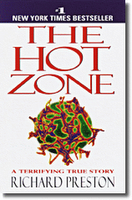Here are the two more recent titles:

To read about the other three titles, click here.Plagues and Peoples by William H. McNeill (Anchor Books, 1976)
The primary challenge for modern historians of epidemic: creating a storytelling technique capable of zooming across multiple scales, from the now-visible kingdom of microbes all the way to the vast superorganisms of the cities where those microbes so often thrive. "Plagues and Peoples" is a sweeping history of human society with microscopic agents of disease as the main protagonists. McNeill describes the parallels between what he calls the "micro-parasites" of disease agents and the "macro-parasites" of human organizations--barbarian hordes, say, or urban centers: "Looked at from the point of view of other organisms, humankind . . . resembles an acute epidemic disease."
The Hot Zone by Richard Preston (Random House, 1994)
Ironically, the most compulsively readable book in the literature of epidemic takes as its subject matter an outbreak that didn't quite happen.
Preston's account of a near-miss with Ebola in the suburbs of Washington reads like a thriller, but the book manages an artful fusion of Thucydides and McNeill in its portrait of Ebola. No one has ever captured the gruesome physical assault of a disease with such engaged repulsiveness. (Preston's descriptions of live human bodies liquefying stay with you for years.) But this is not merely a gross-out diversion. Preston also places that intimate assault in a global context, in the reservoirs of unknown viruses lurking in the world's tropical rainforests, now introduced to mankind by incursions like Africa's Kinshasa Highway, the curse of an all-too-connected world.
Steven Johnson's The Ghost Map, about a cholera outbreak in 19th-century London, will be published in October. He wrote about the book (before it was finished) on his blog:
--Marshal Zeringue
It's the story of the Broad Street cholera outbreak that took place in London in September of 1854. The outbreak itself was arguably the deadliest in London's history--it literally decimated the western side of Soho, killing more than ten percent of the population there in a matter of eight days--but it is most famous for the map that the physician and epidemiologist John Snow made of the outbreak, a map that eventually helped convince the world that cholera was in fact a waterborne illness, and not transmitted via the air as the then-dominant miasma theory maintained....
The Ghost Map is in part a disease thriller, with some genuinely spooky and unsettling narrative turns. But it also widens its focus to tell the history of London's sewer system, the evolutionary history of bacteria, the biological and cultural roots of the miasma theory, the bizarre waste management techniques of Victorian society, and so on. It is the story of ten days in London in 1854, but it's also an attempt to tell that story at three different scales of experience: from the point of view of the humans living through it, but also from the point of view of the cholera itself, and the city.







